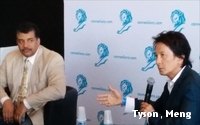Cannes Turns Cosmic: Explores Art & Science, Literally
- by Luke Paul Mandese , June 20, 2014

CANNES, FRANCE -- You might not think that advertising creativity and astrophysics have a lot in common -- other than being in the same universe -- but that didn’t stop Ogilvy & Mather from pairing global creative chief Tham Khai Meng with celebrity astrophysicist Neil deGrasse Tyson in a seminar on “Cosmic Quandaries And Creativity.” The seminar features Tyson doing his patented schtick of entertaining, informing and educating his audience about science without being too condescending, but drew few actual connections to the world of advertising, other than to show an old Americana advertisement for a laxative water branded “Pluto.”
It was ironic, because Tyson is best known for helping to re-brand its astral body from a planet to a less significant planetoid, much to the chagrin of many schoolchildren and others. It wasn’t clear what the connection between the ad and the planetoid’s name was, but Tyson said it was not a scientist who actually named it.
advertisement
advertisement
There was a much stronger connection between the fields of advertising creativity and astrophysics during an impromptu press briefing with Tyson and Meng that followed the presentation.
In response to an opening question about whether the field of science has a “marketing problem,” Tyson said, it isn’t that “science had bad marketing, it’s that it had no marketing.”
He explained that was because of the historical impetus for scientific endeavors was organized primarily by “governments,” which were more concerned with applying the principles of “matter, motion and energy” for military outcomes than they were with other societal benefits that might have required it to be marketed more, well, scientifically.
But Tyson did imply that marketing did develop a marketing problem after the Cold War, when some of the military impetus went away. “All of a sudden science got viewed as a luxury activity as a wealthy society, rather than a necessary activity as a civilization.”
That’s when the conversation switched to creativity and O&M’s Meng asserting the world is entering a “Platinum Age of creativity,” to which Tyson quipped: “What happens after the Platinum Age? You need to find an element that goes beyond that. I can help you find it.”
Tyson and Meng did a better job of drawing a connection between advertising creativity and science than providing any tangible examples of it, but a subsequent seminar sponsored by Dentsu provided some explicit examples. Actually, they demonstrated them.
The presentation by Dentsu Executive Creative Director Yasuharu Sasaki and Sony Computer Science Lab’s Jun Rekimoto showed actual examples of science being applied to develop new forms of “human augmentation” to experience the world differently. While the presenters did not make explicit connections to advertising applications, they did show how new forms of man/machine interface -- especially ones in which consumers “jack-in” to computerized interfaces enabling them to experience or control “out-of-body” experiences -- could be applied to sports.
Dentsu’s Sasaki said it wasn’t clear what the long-term applications of these scientific endeavors would be for sports, advertising or even society, but in the near term, he said the team’s focus is on developing ones that are “entertaining.”<


